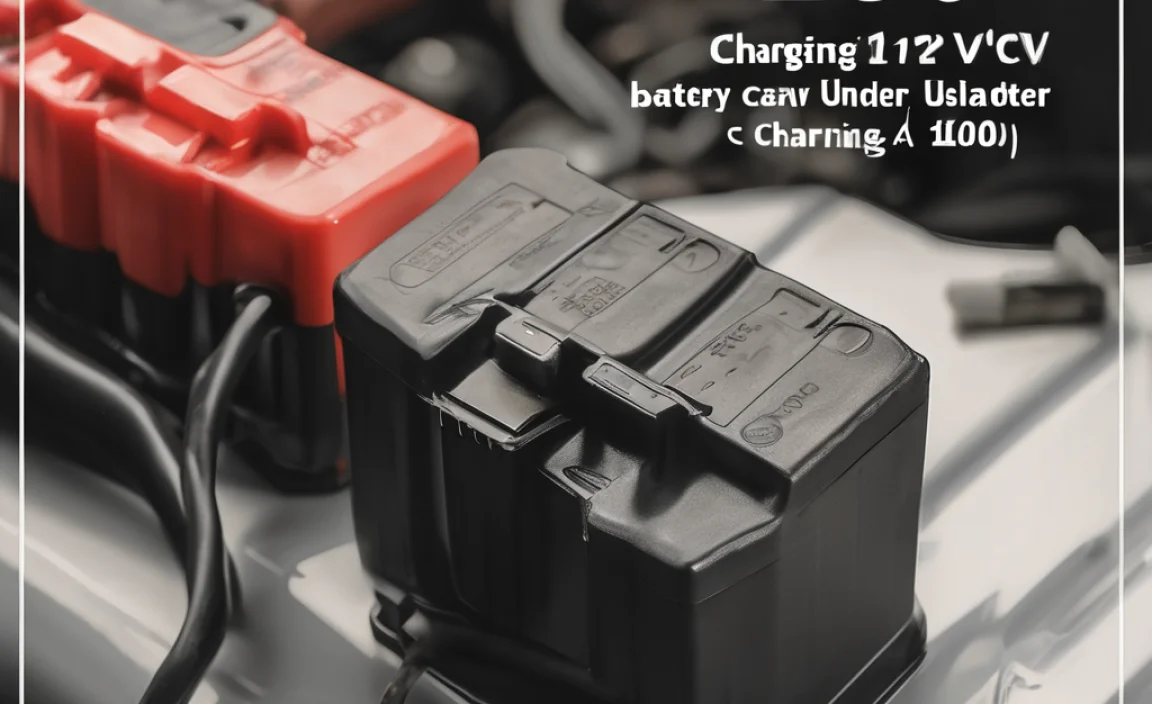Quick Summary: A 12-volt battery is crucial for your garage door opener to work during power outages. Choosing the right one ensures reliable operation. This guide will help you understand what’s essential, how to select it, and keep it working smoothly.
Is there anything more annoying than trying to get out of your driveway during a storm, only to find your garage door opener won’t budge because the power’s out? It’s a common headache, but one that’s easily fixed with the right backup. Your garage door opener often relies on a trusty 12-volt battery to keep things running when the grid goes down. Don’t let a dead battery leave you stranded! We’ll break down everything you need to know about these essential power sources, from understanding why you need one to picking the perfect replacement. Get ready to feel confident about your garage door’s backup power!
Why Your Garage Door Opener Needs a 12-Volt Battery Backup
Think of the 12-volt battery in your garage door opener like a superhero suit for your opener. It waits patiently, ready to jump into action when the main power supply disappears. Most modern garage door openers are equipped with a battery backup system. This isn’t just a nice-to-have; it’s a critical feature for convenience and safety.
When the power flickers out, the battery seamlessly takes over, allowing you to open and close your garage door just like you normally would. This means no more struggling to lift that heavy door by hand, especially in bad weather or when you’re in a hurry. It also ensures your security isn’t compromised, as you can still get your car in and out of the garage.
Many openers will also send an audible or visual alert when the backup battery is low or needs replacing, so you’re usually not caught completely off guard. Keeping this battery in good condition is key to consistent performance.
Understanding 12-Volt Batteries: The Basics
So, what exactly is a 12-volt battery, and why is it the standard for many garage door openers? A 12-volt battery is an electrochemical device that stores energy. The “12-volt” refers to its nominal voltage, which is the standard electrical potential it operates at. This voltage is common across many applications, from car batteries to small electronic devices.
For garage door openers, this voltage is just right. It provides enough consistent power to operate the motor that lifts and lowers the door without requiring a massive, bulky battery. These batteries are typically sealed lead-acid (SLA) batteries. You might also see them referred to as maintenance-free batteries because they don’t require you to add water, unlike older car batteries.
The capacity of a 12-volt battery, measured in Ampere-hours (Ah), tells you how much energy it can store. A higher Ah rating generally means the battery can power your opener for longer periods without a recharge or a power source. For garage door openers, the Ah rating is usually moderate, designed to provide anywhere from a few open/close cycles to several hours of standby power.
Common Types of 12-Volt Batteries for Garage Openers
While most garage door opener batteries are sealed lead-acid (SLA), there are a few variations and specific types to be aware of:
- Sealed Lead-Acid (SLA) Batteries: These are the most common. They are reliable, relatively inexpensive, and designed to be maintenance-free. They can be mounted in any orientation.
- AGM (Absorbent Glass Mat) Battery: A type of SLA battery where the electrolyte is absorbed into fiberglass mats. They offer excellent vibration resistance and a longer lifespan than standard flooded lead-acid batteries.
- Gel Batteries: Another type of SLA where the sulfuric acid is turned into a gel. Gel batteries are known for their deep discharge capabilities and can often withstand temperature extremes better.
When you’re looking to replace your garage door opener battery, you’ll often find specific battery models designed to fit particular brands and opener models. However, the core technology is usually SLA.
For more in-depth information on battery technology and types, you can explore resources like the U.S. Department of Energy’s Battery Technologies page.
When to Replace Your Garage Door Opener Battery
Your garage door opener battery doesn’t last forever. Over time, its ability to hold a charge diminishes. Here are the key signs that it’s time for a replacement:
- Opener Fails During Power Outages: This is the most direct indicator. If your opener doesn’t work when the power is out, but works fine when it’s on, the battery is likely dead or needs a charge. Most backup batteries are designed to provide at least 10-20 cycles in an outage.
- Audible or Visual Alerts: Many newer openers will beep or flash a light to signal that the battery is low or has been recently used extensively. Check your opener’s manual for what these signals mean.
- Reduced Performance: You might notice the opener sounds weaker or struggles to lift the door, especially during normal operation if the battery is significantly depleted.
- Age: Garage door opener batteries typically last between 3 to 5 years. If yours is approaching or has passed this age, it’s wise to consider replacing it proactively, even if you haven’t noticed any issues yet.
Replacing the battery before it fails completely is always the best strategy to avoid being inconvenienced.
Choosing the Right 12-Volt Battery: What to Look For
Selecting the correct 12-volt battery for your garage door opener is straightforward if you know what to check. Here’s a simple guide:
1. Consult Your Opener’s Manual
This is your absolute first step. Your garage door opener’s manual will specify the exact battery type, size, and often, the part number required. It will also tell you the recommended voltage (which should be 12V) and the minimum Ampere-hour (Ah) rating. Using the recommended battery ensures compatibility and optimal performance.
2. Check the Existing Battery
If you can’t find your manual, you can often find the specifications printed directly on the old battery. Look for markings that indicate the voltage (V) and Ampere-hour (Ah) capacity. You’ll also want to note its physical dimensions and the type of terminals (e.g., spade, ring).
3. Match the Voltage
As mentioned, most openers use 12V batteries. It’s rare, but always double-check your manual or existing battery to confirm you’re not accidentally looking at a different voltage battery, like a 6V.
4. Consider Ampere-Hour (Ah) Capacity
This tells you how long the battery can power your opener. For typical garage door openers, you’ll see batteries ranging from 4Ah to 12Ah or even higher. A higher Ah means more backup power, which is great for areas prone to frequent power outages. However, ensure the physical size of the higher Ah battery will still fit in your opener’s battery compartment.
5. Physical Size and Terminal Type
Batteries come in various physical sizes. You need a battery that will physically fit into the designated battery compartment of your garage door opener. Also, check the terminals – the small metal connectors where wires attach. They need to match the connectors on your opener’s wiring harness.
6. Brand and Model Specifics
Some manufacturers, like Chamberlain, LiftMaster, and Genie, have their own branded or specifically designed replacement batteries. While you can often use a high-quality aftermarket battery, using the manufacturer’s recommended battery usually guarantees a perfect fit and function.
For example, LiftMaster and Chamberlain openers often use a model like the LiftMaster 485LM or similar sized batteries. Genie openers might use different models, so checking your specific opener is key.
Essential Tools and Safety Gear
Replacing your garage door opener battery is a straightforward DIY task, but having the right tools and prioritizing safety will make the process smooth and secure.
Tools You’ll Need:
- Screwdriver Set: You’ll likely need a Phillips head and possibly a flathead screwdriver to open the opener’s casing or remove the battery compartment cover.
- Socket Wrench/Nut Driver: Some battery compartments might be secured with small nuts or bolts.
- Wire Brush or Battery Terminal Cleaner: To clean any corrosion off the battery terminals and connectors for a better connection.
- New 12-Volt Battery: The correct replacement battery for your specific garage door opener model.
- Gloves: To protect your hands from any grime or potential battery acid.
- Safety Glasses: Essential for protecting your eyes.
- Company Gloves
Safety Precautions to Take:
- Disconnect Power: Before doing anything else, always unplug your garage door opener from the electrical outlet. Safety first!
- Wear Safety Gear: Always wear gloves and safety glasses. Batteries, especially older ones, can sometimes have corrosion.
- Handle with Care: Avoid dropping the battery.
- Proper Disposal: Never throw old batteries in the regular trash. They contain materials that can be harmful to the environment. Many auto parts stores, home improvement stores, and hazardous waste facilities accept old batteries for recycling. Check with your local recycling center for options.
- Avoid Sparks: Keep metal objects away from the battery terminals, as they can create a short circuit and sparks.
Following these simple steps ensures you have everything ready and keep yourself safe throughout the battery replacement process.
Step-by-Step Guide: Replacing Your Garage Door Opener Battery
Ready to get your backup power back online? Follow these easy steps:
Step 1: Power Down and Prepare
- Locate your garage door opener unit, usually mounted on the ceiling.
- Unplug the opener from the electrical outlet. This is the most critical safety step.
- Open the cover of your garage door opener. This is often secured by clips or a few screws.
- Locate the battery backup unit. It might be a separate brick-like component or integrated into the main opener housing.
Step 2: Remove the Old Battery
- Identify the battery terminals. There should be two wires connected to two terminals on the battery.
- Carefully disconnect the wires. They usually pull straight off. If they are difficult, gently wiggle them. Note which wire goes to which terminal (positive and negative).
- Once disconnected, you can remove the old battery from its compartment. It might lift straight out, or you may need to slide it or unlatch it.
Step 3: Clean and Inspect
- Inspect the battery compartment and the wire connectors.
- If you see any corrosion on the terminals or connectors, use a wire brush or terminal cleaner to gently scrub them clean. This ensures a good electrical connection.
- Wipe down the compartment if it’s dusty or dirty.
Step 4: Install the New Battery
- Place the new 12-volt battery into the compartment, making sure it fits snugly.
- Reconnect the wires to the correct terminals. Typically, red is positive (+) and black is negative (-).
- Ensure the connections are firm and secure.
Step 5: Reassemble and Test
- Replace the cover of the garage door opener unit and secure it with screws or clips.
- Plug the opener back into the electrical outlet.
- Wait a few minutes for the new battery to start charging. Some openers have an indicator light showing battery charging status.
- Test the opener using your remote or keypad.
- Simulate a power outage: Unplug the opener again and try operating the door with the remote. It should work smoothly.
- Plug the opener back in.
Step 6: Dispose of the Old Battery Properly
- Take your old battery to an authorized recycling center. Many auto parts stores or local hazardous waste collection sites accept them.
Congratulations! You’ve successfully replaced your garage door opener battery and ensured it’s ready for any power interruption.
Battery Maintenance and Longevity Tips
Just because you’ve replaced the battery doesn’t mean you’re done! A little bit of care can go a long way in extending the life of your new 12-volt battery.
- Regular Testing: Periodically (every few months), test your opener during a simulated power outage (unplug it and use the remote). This helps ensure the battery is working and that you remember the process.
- Keep it Charged: Ensure the opener is always plugged into a working power outlet. The main unit charges the backup battery.
- Avoid Extreme Temperatures: While garage door openers are designed to work in varied temperatures, extreme heat or cold can affect battery life. If your garage gets extremely hot or cold, consider if this affects the opener unit and its components over time.
- Clean Terminals: If you ever notice that the opener is acting up or during annual maintenance, check the battery terminals for any signs of corrosion. Clean as needed.
- Listen for Alerts: Pay attention to any beeps or flashing lights from your opener. They are often indicators that the battery needs attention.
- Don’t Overwork It: In a true power outage, try to limit opening and closing the door to essential uses. Each cycle drains the battery.
By taking these simple steps, you can help ensure your 12-volt battery backup provides reliable power for years to come.
Troubleshooting Common Battery Issues
Even with proper care, you might run into a few hiccups. Here’s how to tackle some common problems:
- Opener still doesn’t work during power outage after battery replacement:
- Check the connection: Double-check that the battery wires are securely attached to the correct terminals on the new battery.
- Is the battery charged? Ensure the opener is plugged in and has had time to charge the new battery (usually a few hours). Some openers have a charging indicator light.
- Faulty new battery: While rare, the new battery itself could be defective. You might need to test it or swap it for another one.
- Opener motor or logic board issue: The problem might not be the battery at all. If the opener still doesn’t work even with a good, charged battery, the issue could be with the opener’s motor, logic board, or other internal components. In this case, consulting a professional or the manufacturer is advisable.
- Opener is slow or weak:
- Battery not fully charged: The battery might not have had enough time to charge. Leave it plugged in for a full 24 hours.
- Battery nearing end of life: Even if it’s not completely dead, a weakening battery can cause sluggish performance.
- Opener needs lubrication: Sometimes, stiff tracks or rollers can make the opener work harder. Lubricating the tracks and springs can help.
- Opener beeps continuously:
- This is often a signal that the battery is critically low or has failed. Replace the battery. If the beeping continues after replacement, check your opener’s manual for specific error codes.
Remember, if you’re ever unsure or uncomfortable troubleshooting, it’s always best to contact a qualified garage door technician or the manufacturer’s support for assistance.
Comparing Battery Lifespans and Costs
When it’s time to replace your garage door opener battery, understanding the typical lifespans and costs can help you make an informed decision. While most garage door opener batteries are sealed lead-acid (SLA), variations can slightly affect performance and price.
| Battery Type | Typical Lifespan | Estimated Cost | Pros | Cons |
|---|---|---|---|---|
| Standard Sealed Lead-Acid (SLA) | 3-5 years | $20 – $50 | Affordable, widely available, maintenance-free. | Can be sensitive to deep discharges, lifespan can be reduced by extreme temperatures. |
| AGM (Absorbent Glass Mat) Battery | 4-6 years | $30 – $70 | Better vibration resistance, can handle deeper discharges, often longer lifespan than standard SLA. | Slightly more expensive than standard SLA. |
| Gel Battery | 4-7 years | $40 – $80 | Excellent deep discharge capability, good lifespan, can handle temperature fluctuations well. | Can be more expensive
|



